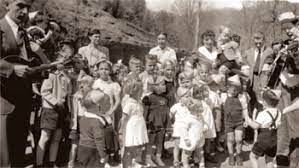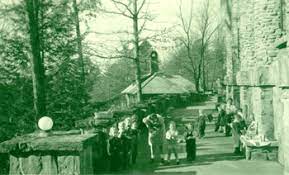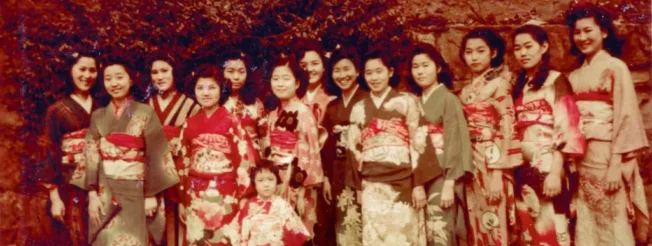US STATE DEPARTMENT CAMPS FOR DIPLOMATS
Homestead Hotel
Hot Springs, Virginia
December 19, 1941 – April 4, 1942
159 German, Italian, Hungarian & Bulgarian diplomats and family members from Washington, DC.; plus 335 Japanese diplomats and family members from Washington, DC; Havana, Cuba; Mexico City, Mexico.
Greenbrier Hotel
White Sulphur Springs, West Virginia
December 19, 1941 – June 1942
The Greenbrier hosted a variety of diplomats and families from Axis countries, and eventually receiving the Japanese from the Homestead Hotel. While the exact number is not easy to determine, apparently the facility hosted up to 852 at various times during the seven-month period.
Grove Park Inn
Asheville, NC
April 3, 1942 – September/October 1942
63 Japanese and 155 German diplomats and families, some who were serving at posts in Latin American countries at the beginning of the war with the United States.
Assembly Inn
Montreat, NC
October 29, 1942 – April 30, 1943
By one list, those detained were 133 Japanese women and children of diplomats; 131 Axis businessmen, diplomats, wives and children. Some were originally situated in Central and Some America nations when WWII broke out.. One State Department representative (Miles Briggs), an Interior Department representative and approximately 5 Justice/INS guards at any one time (up to a total of 25 guards) may have served over the period. Guards included: Louis Cates, Elmer Fisk, Russ Aveilhe, Sanders, Hart and Kersis.
Other hotels holding small numbers of diplomats and businessmen and families temporarily during WWII included:
- Ingleside Hotel (Staunton, Virginia) – German diplomats
- Cascade Inn (Hot Springs, Virginia) – diplomats
- Shenvalee Hotel (New Market, Virginia) – Italian diplomats
- Bedford Springs Hotel (Bedford Springs, Pennsylvania)
Elizabeth Barr Bowers worked for MRA President R. C. Anderson during this period. She and Rachel Hassel were room clerks. Below are some photos from Elizabeth Barr’s scrapbook of the businessmen, diplomats and families from October 29, 1942 to April 30, 1943:

German diplomats and children enjoy a guitar player (far right) at a small party on Assembly Drive near Lake Susan.

1942 Christmas note from Wilhelm Wagener, wife Karla and daughter Ursula to Assembly Inn Clerk Elizabeth Barr (Bowers).

Children and others are shown on the patio outside Assembly Inn.

A rare color photo of some of the Japanese teenagers and a younger child in kimonos for a special occasion while they were in Montreat at the State Department Detention Camp for diplomats’ and businessmen’s families, while waiting for repatriation to Japan. Repatriation didn’t occur for all before the war ended.
Left-to-right are: Michiko Okaji, Shizuko Carolyn Fujisawa, Shigeko Okaji, Taeko Carol Miyamoto, Kiyoko June Kiyohara, Miyeko Ella Ohta, Michiko Jane Asami, Sugako Isobe, Toshiko Marianne Matsumura, Nobuko Saito, Sumie Betty Ohta, Mariko Mary Kojima and Satoko Isobe. The young girl in front is not identified. Some of these individuals had resided in Hawaii before the outbreak of the war.*
World War II Detention of Axis Diplomats, Businessmen, & Families
Background
With the sudden involvement of the United States in World War II as a result of the bombing of Pearl Harbor on December 7, 1941, by the Japanese military, diplomats from both sides were caught in what were now enemy countries.
International protocol urged above average treatment of such diplomats, non-combatants (such as business executives and owners) and their dependents while awaiting repatriation, as well as provisions to ensure their safety.
The Special War Problems Division of the U.S. State Department operated a small number of detention facilities during WWII. “Special war problems” included Axis-allied diplomats, consular corps staff and their families, as well as executives from Axis-owned businesses located pre-war in the U.S. or in Latin American countries. These diplomats, non-citizens from Axis countries, businessmen and their families were held in hotels, pending repatriation. The same was done in Germany for American diplomats and families, for example in Marienbad. Missionaries, diplomats and others were held in Japan.
In the U.S., these diplomats, businessmen and families were detained inland for short periods of time at Appalachian hotels and resorts, such as the Greenbrier Hotel, the Homestead, the Grove Park Inn, Ingleside Hotel, Shenvalee Hotel and Montreat’s Assembly Inn. These diplomats and families began being transferred to these hotels on December 19, 1941. Everyday operations of these facilities were handled by the Immigration & Naturalization Service. One present-day author described the treatment afforded these diplomats and families as provided in “a regal manner… the United States hoped its diplomatic officials would receive similar treatment.”
A State Department memorandum in 1942 reported that 785 people were interned in these hotels. Additional businessmen, diplomats and families were later added during 1943. Exchanges of diplomats and families were made numerous times during 1942 – 1944 through neutral country ships at neutral ports. The U.S. used Swedish ships Drottningholm and the Gripsholm for repatriation on 33 voyages. The last internment hotel operated by the State Department closed on February 14, 1944. More details on these hotels and their wartime detainees are at lower right. Not all detainees were repatriated and many at the end of WWII stayed in the United States.
Montreat, Diplomatic & Business Confinement
In October 1942, State Department officials requested that Montreat provide housing for Axis businessmen, some diplomats and other non-citizens, as well as their families, for a short period of time. The Montreat Retreat Association agreed to house these civilians until April 1st (later extended to April 30), 1943, due to a planned meeting in Montreat for May 1943 by the General Assembly of the Presbyterian Church in the United States. On October 29, 1942, 264 to 268 businessmen, diplomats, wives and children were transported to Montreat.
The German and other Axis allied countries’ contingent was housed on the two lower floors of Assembly Inn, with the Japanese women and children primarily on the upper third floor.
The MRA placed a Japanese language New Testament or German-language Bible in the appropriate hotel rooms. The diplomats and dependents could exercise in the parking areas of Assembly Inn, and roam territory from the hotel to the lake, between the dam and the upper concrete bridge at the head of the lake. Two of the guards are shown at right.
At Christmas time, presents were provided by the MRA to the Japanese and German children — paid for by contributions from the Sunday School of the First Presbyterian Church of Spartanburg and others.
Reportedly on Christmas Eve 1942, young people from Black Mountain gathered at the lake bridge and joined in signing Christmas carols with the diplomatic families — singing “Joy to the World” and “O Holy Night.”
From the State Department revenues received by the MRA, $25,000 was held in reserve and used when the Historical Foundation building (Spence Hall) was constructed in 1954.
On February 14, 1944, the Justice Department closed the last of its program housing diplomats in confinement hotels.
*Additional Information on those pictured provided by J.D. Wilson:
All but one (Toshiko Marianne Matsumura who was born in Fresno, CA) were from Hawai’i – born in Hawai’i .
Michiko and Shigeko Okaji were the daughters of Toyomi Okaji, a sugar cane farmer
Carolyn Shizuko Fujisawa was the daughter of Shunan Fujisawa, a Buddhist priest
Taeko Carol Miyamoto was the daughter of Buntetsu Miyamoto, a Buddhist priest
Kiyoko (Sayeko) June Kiyohara was the daughter of Tetsuei Kiyohara, a Buddhist priest
Miyeko and Sumie Betty Ohta were the daughters of Kunio Ohta, a Buddhist priest
Michiko Jane Asami was the daughter of Shoichi Asami, editor of the Nippu Jiji newspaper
Sugako and Satoko Isobe were the daughters of Misao Isobe, Chief priest, Kotohiro Jinsha Shinto Shine
Nobuko Saito was the daughter of Jogen Saito, a Buddhist priest
Mariko Mary Kojima was the daughter of Teikichi George Kojima, a book store owner
All of the Hawaiians were part of a group of 40 families (around 130 wives, mothers and children) who traveled from Honolulu on 18 August 1942 to meet up with their husbands / fathers for what was to be the second prisoner exchange with Japan. They traveled by train from Oakland, CA through Utah and Chicago, IL to the Grove Park Inn in Ashville where they stayed for about two months. In October they were moved to the Assembly Inn. In April 1943 they were moved to the internment camp at Crystal City, Texas.
The Kiyohara, Asami, and Isobe families repatriated to Japan as part of the second and final prisoner exchange with the Empire of Japan – sailing on the M.S. Gripsholm on September 2, 1943.
